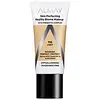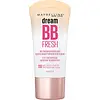Almay Skin Perfecting Healthy Biome Makeup Versus Maybelline Dream Fresh Skin Hydrating BB cream, 8-in-1 Skin Perfecting Beauty Balm with Broad Spectrum SPF 30
What's inside
What's inside
 Key Ingredients
Key Ingredients

 Benefits
Benefits

 Concerns
Concerns

 Ingredients Side-by-side
Ingredients Side-by-side

Water
Skin ConditioningCyclopentasiloxane
EmollientButyloctyl Salicylate
Skin ConditioningCetyl PEG/PPG-10/1 Dimethicone
EmulsifyingTrimethylsiloxysilicate
EmollientGlycerin
HumectantIsododecane
EmollientAlumina
AbrasiveMagnesium Sulfate
Silica
AbrasiveAlpha-Glucan Oligosaccharide
CleansingCaprylic/Capric Triglyceride
MaskingCaprylyl Glycol
EmollientCetyl Palmitate
EmollientDisteardimonium Hectorite
StabilisingHydrogen Dimethicone
Hydrogenated Lecithin
EmulsifyingLactobacillus
Skin ConditioningMaltodextrin
AbsorbentOphiopogon Japonicus Root Extract
Skin ConditioningPalmitoyl Tetrapeptide-10
Skin ConditioningPolyglyceryl-3 Diisostearate
EmulsifyingPolymnia Sonchifolia Root Juice
Skin ConditioningPolysorbate 80
EmulsifyingPropylene Carbonate
SolventSimethicone
EmollientSorbitan Stearate
EmulsifyingTetrasodium EDTA
Tocopheryl Acetate
AntioxidantTriethoxycaprylylsilane
Phenoxyethanol
PreservativeIron Oxides
CI 77492
Cosmetic ColorantCI 77499
Cosmetic ColorantCI 77891
Cosmetic ColorantWater, Cyclopentasiloxane, Butyloctyl Salicylate, Cetyl PEG/PPG-10/1 Dimethicone, Trimethylsiloxysilicate, Glycerin, Isododecane, Alumina, Magnesium Sulfate, Silica, Alpha-Glucan Oligosaccharide, Caprylic/Capric Triglyceride, Caprylyl Glycol, Cetyl Palmitate, Disteardimonium Hectorite, Hydrogen Dimethicone, Hydrogenated Lecithin, Lactobacillus, Maltodextrin, Ophiopogon Japonicus Root Extract, Palmitoyl Tetrapeptide-10, Polyglyceryl-3 Diisostearate, Polymnia Sonchifolia Root Juice, Polysorbate 80, Propylene Carbonate, Simethicone, Sorbitan Stearate, Tetrasodium EDTA, Tocopheryl Acetate, Triethoxycaprylylsilane, Phenoxyethanol, Iron Oxides, CI 77492, CI 77499, CI 77891
Titanium Dioxide
Cosmetic ColorantWater
Skin ConditioningEthylhexyl Palmitate
EmollientGlycerin
HumectantOctyldodecanol
EmollientSilica
AbrasivePentylene Glycol
Skin ConditioningOctyldodecyl Xyloside
EmulsifyingPhenoxyethanol
PreservativeSodium Acrylate/Sodium Acryloyldimethyl Taurate Copolymer
Emulsion StabilisingHydrogenated Lecithin
EmulsifyingIsohexadecane
EmollientHydroxyethyl Acrylate/Sodium Acryloyldimethyl Taurate Copolymer
Emulsion StabilisingPEG-30 Dipolyhydroxystearate
EmulsifyingSodium Dehydroacetate
PreservativePentaerythrityl Tetra-Di-T-Butyl Hydroxyhydrocinnamate
AntioxidantCaprylyl Glycol
EmollientDisodium EDTA
Citric Acid
BufferingPolysorbate 80
EmulsifyingPotassium Sorbate
PreservativePropylene Glycol
HumectantChamomilla Recutita Flower Extract
MaskingAloe Barbadensis Leaf Extract
EmollientIron Oxides
Titanium Dioxide, Water, Ethylhexyl Palmitate, Glycerin, Octyldodecanol, Silica, Pentylene Glycol, Octyldodecyl Xyloside, Phenoxyethanol, Sodium Acrylate/Sodium Acryloyldimethyl Taurate Copolymer, Hydrogenated Lecithin, Isohexadecane, Hydroxyethyl Acrylate/Sodium Acryloyldimethyl Taurate Copolymer, PEG-30 Dipolyhydroxystearate, Sodium Dehydroacetate, Pentaerythrityl Tetra-Di-T-Butyl Hydroxyhydrocinnamate, Caprylyl Glycol, Disodium EDTA, Citric Acid, Polysorbate 80, Potassium Sorbate, Propylene Glycol, Chamomilla Recutita Flower Extract, Aloe Barbadensis Leaf Extract, Iron Oxides
 Reviews
Reviews

Ingredients Explained
These ingredients are found in both products.
Ingredients higher up in an ingredient list are typically present in a larger amount.
Caprylyl Glycol is a humectant and emollient, meaning it attracts and preserves moisture.
It is a common ingredient in many products, especially those designed to hydrate skin. The primary benefits are retaining moisture, skin softening, and promoting a healthy skin barrier.
Though Caprylyl Glycol is an alcohol derived from fatty acids, it is not the kind that can dry out skin.
This ingredient is also used as a preservative to extend the life of products. It has slight antimicrobial properties.
Learn more about Caprylyl GlycolGlycerin is already naturally found in your skin. It helps moisturize and protect your skin.
A study from 2016 found glycerin to be more effective as a humectant than AHAs and hyaluronic acid.
As a humectant, it helps the skin stay hydrated by pulling moisture to your skin. The low molecular weight of glycerin allows it to pull moisture into the deeper layers of your skin.
Hydrated skin improves your skin barrier; Your skin barrier helps protect against irritants and bacteria.
Glycerin has also been found to have antimicrobial and antiviral properties. Due to these properties, glycerin is often used in wound and burn treatments.
In cosmetics, glycerin is usually derived from plants such as soybean or palm. However, it can also be sourced from animals, such as tallow or animal fat.
This ingredient is organic, colorless, odorless, and non-toxic.
Glycerin is the name for this ingredient in American English. British English uses Glycerol/Glycerine.
Learn more about GlycerinHydrogenated Lecithin is created from the hydrogenation of lecithin (a group of phospholipids). Hydrogenation is a chemical reaction between hydrogen and another element.
This ingredient is an emollient and emulsifier. As an emollient, it helps soften skin by trapping moisture within. As an emulsifier, it prevents oil and water ingredients from separating.
Phenoxyethanol is a preservative that has germicide, antimicrobial, and aromatic properties. Studies show that phenoxyethanol can prevent microbial growth. By itself, it has a scent that is similar to that of a rose.
It's often used in formulations along with Caprylyl Glycol to preserve the shelf life of products.
Polysorbate 80 is a surfactant and emulsifier. It is used to keep ingredients together, and prevent oils and waters from separating.
It is made from polyethoxylated sorbitan and oleic acid. This ingredient can be found in cosmetics, foods, and medicine. It is water-soluble.
Polysorbate 80 may not be fungal acne safe.
Learn more about Polysorbate 80Silica, also known as silicon dioxide, is a naturally occurring mineral. It is used as a fine, spherical, and porous powder in cosmetics.
Though it has exfoliant properties, the function of silica varies depending on the product.
The unique structure of silica enhances the spreadability and adds smoothness, making it a great texture enhancer.
It is also used as an active carrier, emulsifier, and mattifier due to its ability to absorb excess oil.
In some products, tiny microneedles called spicules are made from silica or hydrolyzed sponge. When you rub them in, they lightly polish away dead skin layers and enhance the penetration of active ingredients.
Learn more about SilicaWater. It's the most common cosmetic ingredient of all. You'll usually see it at the top of ingredient lists, meaning that it makes up the largest part of the product.
So why is it so popular? Water most often acts as a solvent - this means that it helps dissolve other ingredients into the formulation.
You'll also recognize water as that liquid we all need to stay alive. If you see this, drink a glass of water. Stay hydrated!
Learn more about WaterThis ingredient is a combination of red, black, and yellow iron oxide pigments. This combination of colors is usually found in foundation, because it results in a "skin" color.